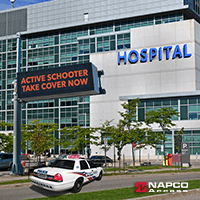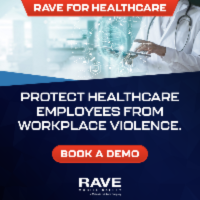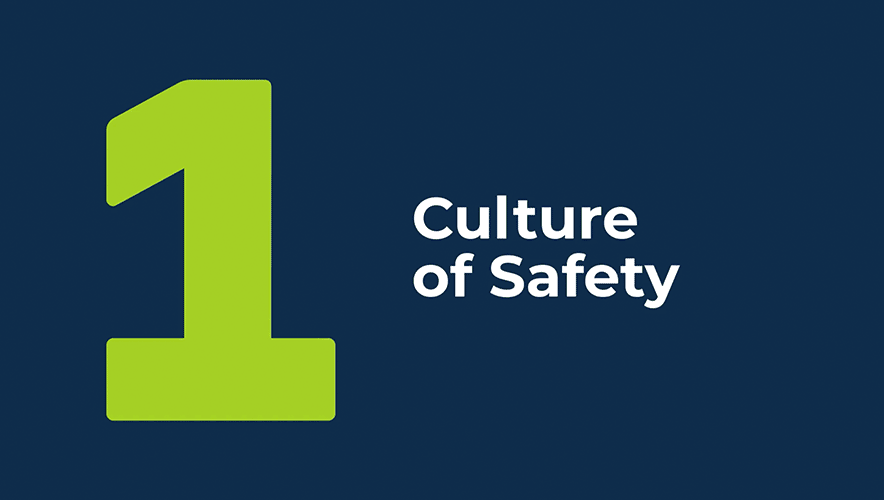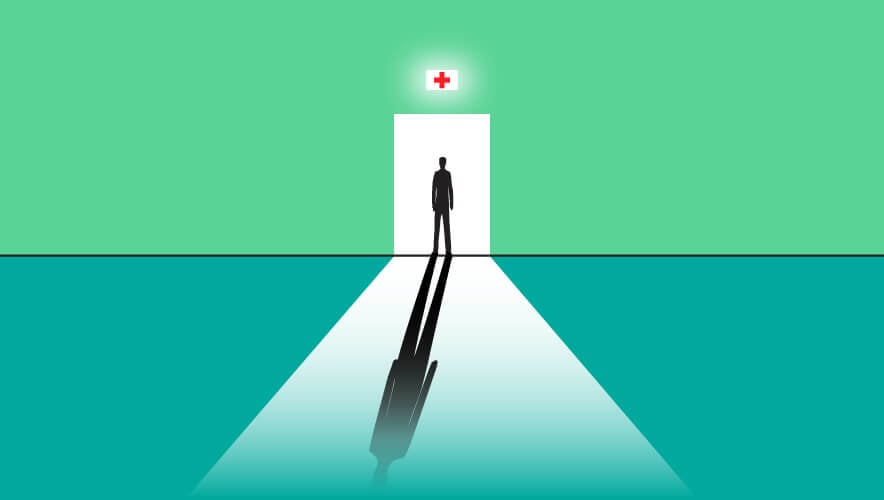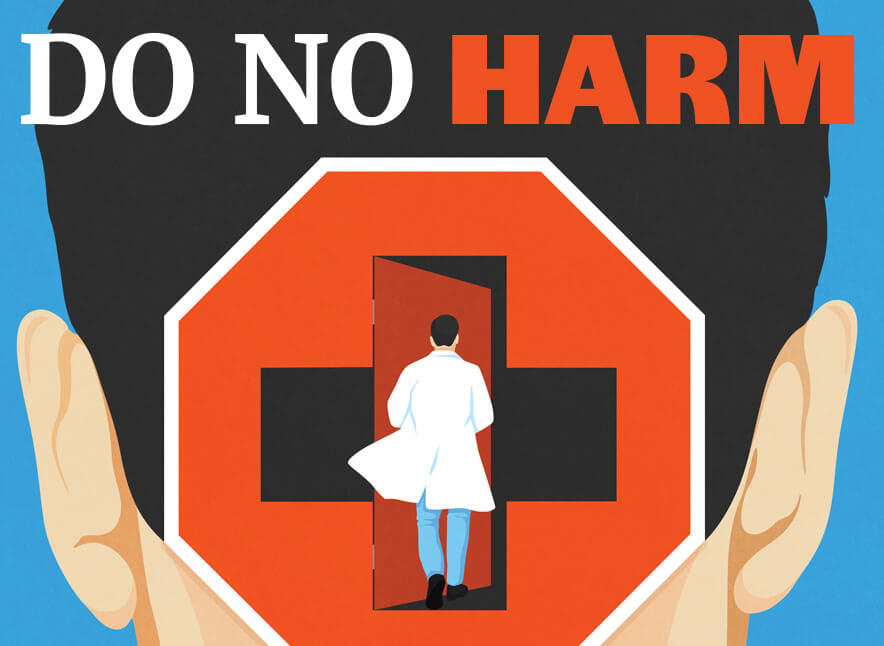Shaping Workplace Violence Mitigation Strategies for a Healthy Hospital
Workplace violence stems from a broad range of sources. It can come from employees, customers, a person indirectly connected to a company, or even from someone with no affiliation whatsoever to the organization. Violence from external or unknown sources makes preparation especially difficult. And grievances converging at a workplace can present through a range of expressions.
The U.S. Bureau of Labor Statistics found that in 2019, out of 5,333 fatal workplace injuries, 761 were the result of intentional injury from another person. In January 2023, the U.S. Secret Service National Threat Assessment Center estimated that half of the number of U.S. mass attacks from 2016 to 2020 were caused by personal, domestic, or workplace disputes.
SponsoredUpdate Access-Control /Video & Integrated Security for End-to-End Protection Inside & Out + Proven Faster Response to Healthcare Workplace Violence Emergencies - Let NAPCO Show You How FREENAPCO Integrated Security Management Solutions ensure faster, smarter First Response, informed Bad-Actor-pinpointing, Threat-Level Management, Alerts, Global-Lockdown/Area-Lockdown for Man-Traps to contain threats & Muster-Reporting. FREE Onsite Evaluation/Consult. |
However, workplace violence is not limited to physical acts causing bodily injury. It also includes threats of violence, harassment, and intimidation—such as bullying. This amounts to approximately 2 million people who will be victims of workplace violence each year in the United States. In 2020, U.S. sources tallied more than 400,000 aggravated assaults with 20,000 reports of injury, and nearly 400 deaths from workplace violence incidents.
Additionally, a significant number of workplace violence events are also occurrences of intimate partner violence. The victim may have taken proactive steps to be less available to the attacker—he or she may have moved, gotten a new car, and changed their phone number. But victims rarely find a new employer, and the attacker likely knows that the victim can be found at work. According to Colibri Healthcare, approximately 45 percent of healthcare workers (doctors and nurses) had been victims of domestic violence.
Compounding the issue is when the attacker is also colleagues with the victim. If the relationship between two employees turns sour, it can often result in issues at work.
In such scenarios, it is not uncommon for the victim to feel embarrassed or vulnerable. His or her private life is now dragged into the workplace. If the aggressor is a coworker, the victim may feel self-conscious that other coworkers know their personal business, and the victim may also fear that a reputation of being promiscuous with coworkers has now emerged.
Compared to most other sectors, workers in healthcare—who represent every cultural background and socioeconomic level—are at a higher risk of workplace violence in the United States. Healthcare staff are exposed to a high amount of violence and are estimated to have a 20 percent higher chance of being a victim of workplace violence than the average worker. A 2021 study published in the U.S. National Library of Medicine found that 12 percent of surveyed emergency room nurses were victims of physical assault.
Hospitals and emergency rooms are extremely sensitive and susceptible places for violence because people there are often under high stress. Medical staff are attempting to give proper care to multiple patients. Family members of the patient are concerned about who is at fault, what caused the issue, and how to pay for the treatment. Patients themselves are often afraid, in pain, or grappling with complex medical conditions. These increased stressors may cause a person to become more unstable and their emotions extremely volatile.
Your Patient, Your Attacker
There are several reasons why a patient may be uncooperative. He or she might be the victim of a crime, severely injured, or be placed in precarious financial situation due to hospitalization. Additionally, any emotionally unstable family members will increase the likelihood of an outburst. While working as a hostage negotiator, I sometimes heard my peers refer to situations involving stressful family members as a “double whammy.”
A person can typically handle a single high stress event. However, when multiple high stress events occur during a relatively short amount of time, it becomes increasingly difficult to control emotions. And extreme emotions can cause unpredictable or even violent responses.
Furthermore, if the patient is a victim of domestic violence, child abuse, or elder abuse, the perpetrators may be at the hospital attempting to hide or deny the discovery of evidence. A common scenario is an elderly person admitted to the hospital who is being defrauded—sometimes by a younger family member. That fraudulent activity can be any number of things but often is financial, such as theft. The person perpetrating the fraud may exhibit heightened sensitivity about medical staff speaking to the patient. The suspect may become defensive and confrontational when medical or security personnel are speaking to them or the patient.
Beyond typical confrontations or conflicts, healthcare facilities also need to manage interactions with people dealing with mental health disorders. There is also the person who enters the emergency room as an involuntary mental health admission and is already in crisis. Someone admitted in this manner may be extremely volatile and should be treated with caution. Mental health disorders are rising in the United States, according to the National Alliance on Mental Illness, increasing the chances of a violent encounter for healthcare personnel.
SponsoredKeep Your Staff Informed And SafeLearn more about a cost-effective way to improve the safety of healthcare staff with the devices they already own. |
Every U.S. state has involuntary mental health admission laws, but they vary slightly from state to state. An involuntary mental health admission usually requires a doctor’s sign-off or for a law enforcement officer to have probable cause. Using the probable cause standard—a standard applied to other types of arrests—law enforcement must establish that a person is in imminent danger, likely to harm themselves or others, or be gravely disabled.
The term “imminent” is vital here. The person will have already directly demonstrated dangerous behavior directly to law enforcement officers or evidence of such behavior has been shown. Examples of this could include an attempted suicide, evidence of a thought-out plan to achieve violence against themselves or others, or the purchase of materials to accomplish violence, such as rope, a firearm, or drugs.
A person who is gravely disabled is someone who has demonstrated an inability to take care of him or herself, causing them to become severely ill or even die due to this level of neglect. While failing to take mental health medication is a common trait among those who are gravely disabled, this alone is insufficient criteria to result in involuntary admission.
Healthcare staff are exposed to a high amount of violence and are estimated to have a 20 percent higher chance of being a victim of workplace violence than the average worker.
A common misconception is that a person experiencing mental health crisis is taken to a mental health facility. However, there are not that many specialized mental health facilities in the United States. About 52.9 million U.S. adults have experienced at least one mental health incident, and there are nearly 600,000 involuntary mental health admissions per year across the country. This does not include anyone who sought help on their own. In comparison, as of 2020 there were roughly 12,275 registered mental health treatment facilities in the United States, and of those only 1,756 facilities offer 24-hour hospital inpatient services—leaving the care of many individuals up to hospital emergency departments.
Solutions Outside an IV Drip
Emergency rooms were not designed for mental health treatment, and someone experiencing a mental health crisis can be violent and volatile. This puts emergency room staff at extreme risk.
One of the major concerns is that emergency rooms are equipped to handle a multitude of emergency health concerns, but as with any issue a broader response translates to waning expertise or quality care when it comes to unusual or specialized cases. This isn’t an attack on healthcare professionals—quite simply, one emergency room can’t handle every issue that arises. Hospital staff are overworked, underappreciated, and often shorthanded.
There are several paths that can support healthcare organizations working to proactively prevent workplace violence—whether from disgruntled employees, violent intimate partners, visitors, or the patients themselves.
Partners in Care
Healthcare workers should have a well-trained and visible security staff along with a collaborative relationship with local law enforcement. Law enforcement officials who feel they have been unwelcome in the healthcare setting will be less likely to support healthcare workers at their facilities. This may include reporting any issue where healthcare staff have been victimized, supporting victims’ rights, and doing things as simple as escorting staff to their vehicles at night.
There are several ways to collaborate with local law enforcement. Healthcare facilities can supply data to law enforcement for peak patient traffic times, as well as data on assaults or other criminal behavior that occur at hospital facilities. Local law enforcement should also have documentation on their response times and purposes. Additionally, healthcare workers should report every instance of crimes against people, including stalking, physical harassment, assault, and so on. This allows law enforcement to better understand the needs of the healthcare facilities and potentially allocate their resources differently.
Hospitals may also want to consider adding uniformed law enforcement officers during typically busy times at a facility; this gives officers an inside view at what healthcare personnel are likely to face on a regular basis. Although the presence of uniformed officers adds to hospital security staff, a facility should not lessen its existing workforce. The cost may seem large upfront, but the healthcare facility isn’t paying for the any of the required training or certifications for the police officers that conduct security functions. Healthcare facilities would also not need to create a firearms program for their own personnel if police officers are taking on that role.
Healthcare facilities should consider that criminal behavior and attacks on healthcare workers will likely decrease when officers are present. Early in my law enforcement career, a hospital in my jurisdiction reported increasing assaults on hospital staff. Hospital management and directors reached out to the police department to hire officers for overtime. This successfully resulted in decreased assaults and other crimes.
Several years later, when the hospital faced some financial issues, the additional law enforcement officers were cut, citing that there was no need for them since crimes and attacks on healthcare workers were at a low. Less than 18 months later, attacks on healthcare personnel and general criminal behavior had risen to previous levels.
Another form of collaboration would be a crisis response unit composed of two police officers trained in crisis intervention, mediation, and crisis negotiation; a paramedic with counseling training; and a civilian counselor. This unit can be used to handle calls involving people with mental health issues. The skills of these personnel can better assess next steps, rather than defaulting to taking such patients to a general emergency room. The unit allows for collaboration across multiple genres, allows for maximum safety for all personnel, and relieves non-specialized police officers to handle other calls.
Healthcare facilities should consider that criminal behavior and attacks on healthcare workers will likely decrease when officers are present.
Hospitals should also consider building better relationships with existing mental health facilities, especially those equipped for stays longer than an involuntary hold of 72 hours. Often emergency rooms play the middleman, determining whether a person should move into those facilities that are often better equipped at dealing with potentially violent people with mental health concerns. Having a direct line to those organizations and strong relationships with the personnel there may reduce pressure on emergency room staff and security personnel.
Casting a Discerning Eye
On the facility’s end, an effective screening process can help mitigate potential violence, and it can start even before a patient interacts with medical personnel. New screening technologies—which can be installed at points of public egress—can detect firearms, knives, and explosives while looking similar to traditional metal detectors.
New camera technologies use artificial intelligence to identify weapons inside of hidden bags or clothing. This can be especially useful for someone approaching the building or if an employee gained access through other means than a public entrance. Cameras and screening technologies require active monitoring.
In addition to monitoring, all facilities should have a check-in process that includes a disclaimer informing patients that carrying weapons in is prohibited. The process should also cite specific crimes that patients could be charged with in the event they bring a weapon, cause a disturbance, or become violent. Sometimes the forced pause, identification, and reminder can be a deterrent.
A good screening and check-in process also occurs away from family members, friends, or other people that a patient arrived with. Ask direct questions about concerning issues, behaviors, or people that are with the patient. But to keep from the interaction appearing invasive, it is most important to maintain a caring attitude, which will result in success in gaining important information and cooperation.
When a person gets admitted to the hospital, questionnaires by healthcare professionals usually include questions about violence and abuse. Well-trained security personnel should be involved in any suspicious or concerning answers and should be able to view and understand behavior of the patient but also understand concerning behaviors of anyone that arrived with the patient or visited them. Early observation and intervention by security can prevent attacks by outsiders.
This means that healthcare security personnel should have excellent training and professionalism. Training should include crisis intervention, de-escalation, and mediation. Additionally, behavioral threat assessment and situational awareness training could provide them better understanding and make it easier to identify potential threats. There should be an active reporting system so that managers can make reports about personnel or patients that go to a person who conducts threat assessments. Threat assessments will need to be handled by a full-time employee.
All of these efforts demand active and healthy support from managers, ensuring that personnel are comfortable in reporting and disclosing incidents that pose a risk to colleagues, patients, and the facility. This includes risks that lie beyond the hospital or facility, such as an abusive partner.
Showing support for employees who have been victims of workplace and/or intimate partner violence can encourage disclosure from staff. Consider providing counseling, paid time off, and access to support services or resources for employees who need additional assistance in breaking away from an abusive relationship. Hospital administration needs to be proactive in any issues between employees with no tolerance from any perpetrator on their staff. Any staff member—regardless of position or rank—will receive the same accountability.
Employee screening should also occur regularly. Mental health professionals are usually tasked with handling the needs of outsiders and patients. Rarely are health professionals the focus, despite being humans with their own lives and issues, and everyday witnesses to traumatic events. Regular employee screenings can not only help identify potential insider threats, but also other various issues that may arise.
Kevin Jones, CPP, has spent nearly 18 years working in law enforcement and over a decade as a crisis and hostage negotiator. He was also a firearms instructor, drug recognition expert, field training officer, investigator, and supervisor. Jones regularly conducts threat assessments and intelligence reports, and he is passionate about crisis intervention, de-escalation, and early intervention. He has experienced firsthand the results of active shooter and workplace violence incidents and strives to help prevent them, including developing training curriculum from personal experiences. He is currently working on attaining a master’s degree in strategic security.

